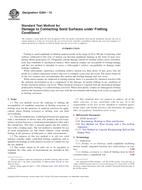Potrebujeme váš súhlas na využitie jednotlivých dát, aby sa vám okrem iného mohli ukazovať informácie týkajúce sa vašich záujmov. Súhlas udelíte kliknutím na tlačidlo „OK“.
ASTM G204-10
Standard Test Method for Damage to Contacting Solid Surfaces under Fretting Conditions
Automaticky preložený názov:
Štandardná skúšobná metóda pre škodu Kontaktovanie povrchu pevných látok v zlostiť podmienky
NORMA vydaná dňa 1.4.2010
Informácie o norme:
Označenie normy: ASTM G204-10
Poznámka: NEPLATNÁ
Dátum vydania normy: 1.4.2010
Kód tovaru: NS-57599
Počet strán: 5
Približná hmotnosť: 15 g (0.03 libier)
Krajina: Americká technická norma
Kategória: Technické normy ASTM
Anotácia textu normy ASTM G204-10 :
Keywords:
fretting, fretting corrosion, fretting wear, ICS Number Code 21.260 (Lubrication systems)
Doplňujúce informácie
| Significance and Use | ||||||||||||
|
Fretting wear and corrosion are potential serviceability factors in many machines. They have always been factors in shipping finished goods by truck or rail. Packing materials rubbing on a product in transit can make the product unsalable. Beverage cans and food cans can lose their trade dress and consumers often equate container damage to content damage. Clamping surfaces on injection molds are damaged by fretting motions on clamping. This damage is a significant cause for mold replacement. Machines in shipment are subject to fretting damage in the real area of contact of the bearings on the machines. Operating vibration and movement of mechanically clamped components, like screwed assemblies, can produce damage on the clamped faces and other faces that affects machine function or use. Many times fretting damage appears in the form of pits, which are stress concentrators that can lead to mechanical fractures. Electrical contacts in any device that is subject to vibration are susceptible to failure (open circuit) due to fretting damage at real areas of contact. This test method is intended to be used to identify mating couples that may be less prone to fretting damage than others. This information in turn is used to select materials of construction or surface treatments that are less prone to fretting damage for applications where fretting conditions are known or perceived to exist. |
||||||||||||
| 1. Scope | ||||||||||||
|
1.1 This test method covers the studying or ranking the susceptibility of candidate materials to fretting corrosion or fretting wear for the purposes of material selection for applications where fretting corrosion or fretting wear can limit serviceability. 1.2 This test method uses a tribological bench test apparatus with a mechanism or device that will produce the necessary relative motion between a contacting hemispherical rider and a flat counterface. The rider is pressed against the flat counterface with a loading mass. The test method is intended for use in room temperature air, but future editions could include fretting in the presence of lubricants or other environments. 1.3 The purpose of this test method is to rub two solid surfaces together under controlled fretting conditions and to quantify the damage to both surfaces in units of volume loss for the test method. 1.4 The values stated in SI units are to be regarded as standard. No other units of measurement are included in this standard. 1.5 This standard does not purport to address all of the safety concerns, if any, associated with its use. It is the responsibility of the user of this standard to establish appropriate safety and health practices and determine the applicability of regulatory limitations prior to use. |
||||||||||||
| 2. Referenced Documents | ||||||||||||
|




 Cookies
Cookies
